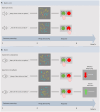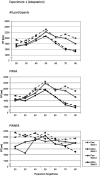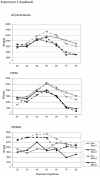Quantifier processing and semantic flexibility in patients with aphasia
- PMID: 39100551
- PMCID: PMC11294751
- DOI: 10.3389/fpsyg.2024.1328853
Quantifier processing and semantic flexibility in patients with aphasia
Abstract
Processing of quantifiers such as "many" and "few" relies on number knowledge, linguistic abilities, and working memory. Negative quantifiers (e.g., "few," "less than half") induce higher processing costs than their positive counterparts. Furthermore, the meaning of some quantifiers is flexible and thus adaptable. Importantly, in neurotypical individuals, changing the meaning of one quantifier also leads to a generalized change in meaning for its polar opposite (e.g., the change of the meaning of "many" leads to the change of that of "few"). Here, we extended this research to patients with fluent and non-fluent aphasia after stroke. In two experiments, participants heard sentences of the type "Many/few of the circles are yellow/blue," each followed by a picture with different quantities of blue and yellow circles. The participants judged whether the sentence adequately described the picture. Each experiment consisted of three blocks: a baseline block to assess the participants' criteria for both quantifiers, a training block to shift the criteria for "many," and a test block, identical to the baseline to capture any changes in quantifier semantics. In Experiment 1, the change of the meaning of "many" was induced by using adaptation to small numbers (20-50%) of circles of the named color. In Experiment 2, explicit feedback was given in the training block after each response to rate proportions of 40% (or higher) as "many," whereas 40% is normally rather rated as "few." The objective was to determine whether people with fluent or non-fluent aphasia were able to process quantifiers appropriately and whether generalized semantic flexibility was present after brain damage. Sixteen out of 21 patients were able to perform the task. People with fluent aphasia showed the expected polarity effect in the reaction times and shifted their criteria for "many" with generalization to the untrained quantifier "few." This effect, however, was only obtained after explicit feedback (Experiment 2) but not by mere adaptation (Experiment 1). In contrast, people with non-fluent aphasia did not change the quantifier semantics in either experiment. This study contributes to gaining new insights into quantifier processing and semantic flexibility in people with aphasia and general underlying processing mechanisms.
Keywords: adaptation; aphasia; feedback; flexibility; learning; quantifier; semantics.
Copyright © 2024 Reißner, Grohmann, Peiseler, Pinho, Hußmann, Werner and Heim.
Conflict of interest statement
The authors declare that the research was conducted in the absence of any commercial or financial relationships that could be construed as a potential conflict of interest.
Figures







References
-
- Abbondanza M., Rinaldi L., Foppolo F., Marelli M. (2021). The mental representation of non-numerical quantifiers: the spatial-linguistic Association of Response Codes (SLARC) effect. Washington, US: Center for Open Science. - PubMed
-
- Agmon G., Loewenstein Y., Grodzinsky Y. (2019). Measuring the cognitive cost of downward monotonicity by controlling for negative polarity. Glossa J. General Linguist. 4:1–18. doi: 10.5334/gjgl.770 - DOI
-
- Amunts K., Weiss P. H., Mohlberg H., Pieperhoff P., Eickhoff S., Gurd J. M., et al. . (2004). Analysis of neural mechanisms underlying verbal fluency in cytoarchitectonically defined stereotaxic space--the roles of Brodmann areas 44 and 45. NeuroImage 22, 42–56. doi: 10.1016/j.neuroimage.2003.12.031 - DOI - PubMed
LinkOut - more resources
Full Text Sources

